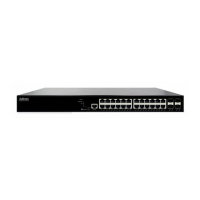Hardware and Software Requirements and Limitations SNMP in the NetVanta 1570
8 6AMCCG0018-29A
SNMP Traps
Trap messages are sent by the SNMP agent to report network conditions or status updates from the network
device. The trap messages are received by the NMS to alert the administrator of current network conditions.
The alarm conditions and thresholds are defined in the ASE MIBs. When the alarms occur within the network
device, the traps are generated and sent out to the NMS. UDP port 162 is the default port used to listen for
SNMP traps. ASE supports the standard traps listed in Table 3.
Trap notifications in SNMPv1 and SNMPv2c are sent once, and do not require an acknowledgment upon
receipt. With SNMPv3, a new form of notification type was introduced, called an inform message. Unlike a trap
sent with SNMPv1/v2c, an inform message requires a response be sent to the originating entity. If the
originator of the inform message notification does not receive the response before a specified timeout, the
originator can resend until an acknowledgment response is received, or a specified retry threshold is reached.
Sending inform messages require that the originator of the inform message know the user, engine ID of the
remote agent, SNMPv3 security parameters (level, authentication, and encryption), and belong to a SNMP
group that grants access to the information.
3. Hardware and Software Requirements and Limitations
SNMP features are supported on the NetVanta 1570 ASE products that are running ASE firmware 20.12-3 or
later as outlined in the NetVanta ASE Switch Feature Matrix on the Adtran Support Community.
Table 3. ASE Supported Standard Traps
Name Description
alarmTrapStatus The status of an alarm trap has changed.
authenticationFail-
ure
The SNMP agent has received a protocol message that is not properly authenticated.
coldStart The SNMP agent is reinitializing, creating an opening to edit its configuration.
entConfigChange The value of entLastChangeTime has changed. This trap can be utilized by an NMS to
trigger logical or physical entity table maintenance polls.
fallingAlarm The monitored object has crossed the defined falling threshold.
ipTrapInterfaces-
Link
The link status on the IP interface has changed.
linkDown The network interface has failed.
linkUp The network connection has been reestablished.
lldpRem-
TablesChange
The LLDP neighbor table has changed.
newRoot A new spanning tree root has been elected.
psecTrapGlobals-
Main
The maximum number of MAC addresses exceeds 1024 addresses, as set in the Secu-
rity > Network > Port Security > Limit Control GUI menu.
psecTrapInterfaces A port security violation has occurred and the violation mode is shut down.
risingAlarm The monitored object has crossed the defined rising threshold.
topologyChange A port in a bridge has changed from Learning to Forwarding or Forwarding to Block-
ing
warmStart The SNMP agent is reinitializing in a manner that prohibits configuration changes.

